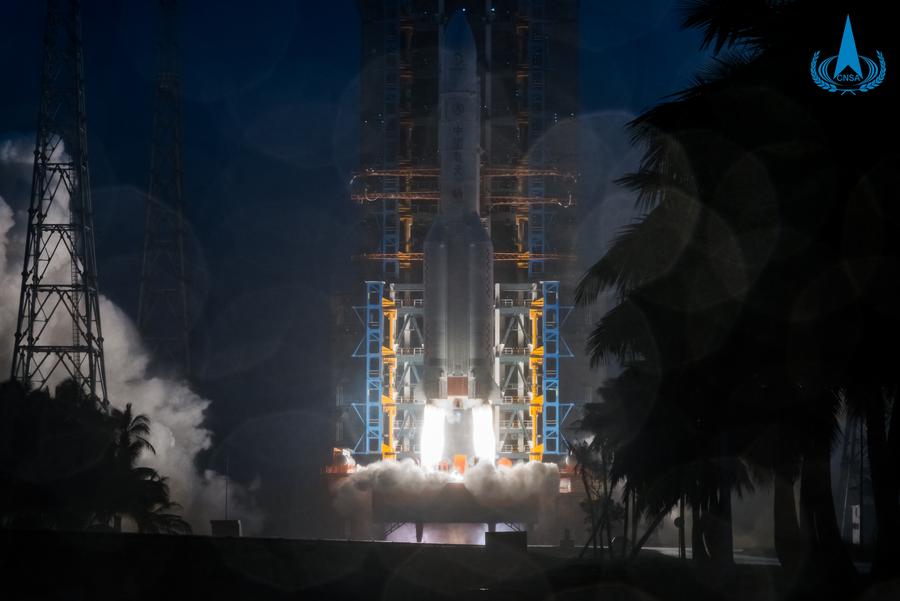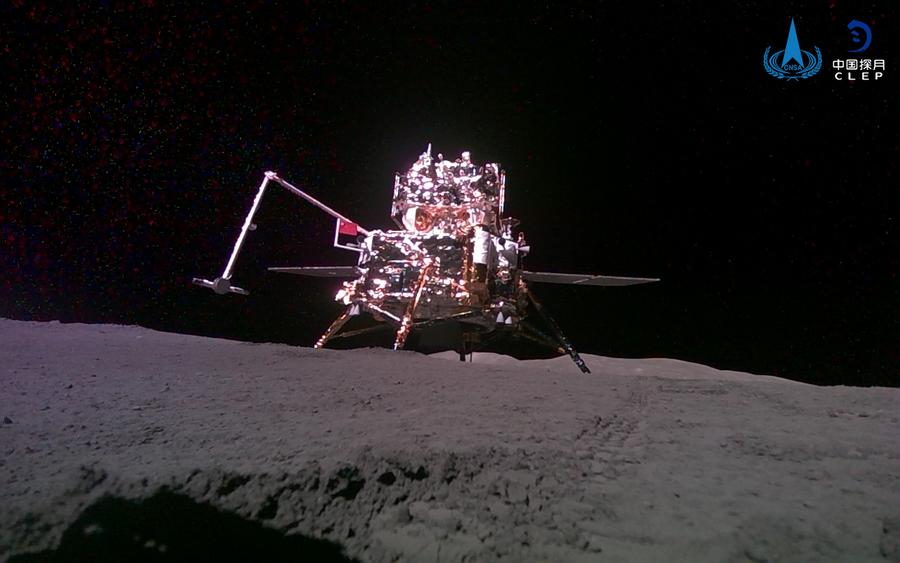China's Chang'e-6 brings back first samples from moon's far side to Earth
BEIJING, June 25 (Xinhua) -- The returner of the Chang'e-6 lunar probe on Tuesday brought back samples collected from the moon's far side for the first time in human history, marking another milestone in China's space exploration endeavors.
The return capsule landed precisely in the designated area in Siziwang Banner, north China's Inner Mongolia Autonomous Region at 2:07 p.m. (Beijing Time), operating normally. The China National Space Administration (CNSA) declared the mission "a complete success."

The return capsule of the Chang'e-6 probe lands in Siziwang Banner, north China's Inner Mongolia Autonomous Region on June 25, 2024. (Xinhua/Jin Liwang)
Chinese President Xi Jinping on Tuesday extended congratulations on the complete success of the Chang'e-6 mission. He called for meticulous research on the lunar samples, the continued implementation of the country's major space projects, including deep space exploration, and enhancement of international exchanges and cooperation.
He also urged efforts to make new contributions to revealing the mysteries of the universe, to promoting the well-being of humanity, and to building a great country and advancing national rejuvenation on all fronts through Chinese modernization.
Under ground control, the returner separated from the orbiter approximately 5,000 km above the South Atlantic.
The capsule entered the Earth's atmosphere at about 1:41 p.m. at an altitude of about 120 km and a speed of nearly 11.2 km per second.
After aerodynamic deceleration, it skipped out of the atmosphere and then glided downwards, before re-entering the atmosphere and decelerating for a second time.
At around 10 km above the ground, a parachute opened, and the returner later landed precisely and smoothly in the predetermined area, where it was recovered by a search team.

This photo taken on June 25, 2024 shows the retrieval site of the return capsule of the Chang'e-6 probe in Siziwang Banner, north China's Inner Mongolia Autonomous Region. (Xinhua/Jin Liwang)
Chang'e-6 is so far the most complicated mission in China's lunar exploration program, and its control difficulty is extremely high, said Peng Deyun, an engineer at the Beijing Aerospace Control Center.
Although the whole process of the spacecraft's re-entry into the atmosphere was quite challenging, the recovery of the returner went on smoothly, Peng said.
The returner is set to be airlifted to Beijing for opening, and the lunar samples will be transferred to a team of scientists for subsequent storage, analysis and study, said the CNSA.
"After the lunar samples are delivered to the laboratory, we will first unseal the sample container, extract the samples, and separate the samples collected on the lunar surface from those drilled under the surface," said Wang Qiong, deputy chief designer of the Chang'e-6 mission.
"A portion of the samples will be stored permanently, while another portion will be stored at a different location as backup in case of disasters. Then we will prepare the remaining portion, and distribute them to scientists in China and foreign countries in accordance with the lunar sample management regulations," he said.
Consisting of an orbiter, a returner, a lander and an ascender, the Chang'e-6 spacecraft was launched on May 3, and has gone through various stages such as Earth-moon transfer, near-moon braking, lunar orbiting and separation of the lander-ascender combination and the orbiter-returner combination.

A Long March-5 rocket, carrying the Chang'e-6 spacecraft, blasts off from its launchpad at the Wenchang Space Launch Site in south China's Hainan Province, May 3, 2024. (CNSA/Handout via Xinhua)
Supported by the Queqiao-2 relay satellite, the lander-ascender combination landed at the designated landing area in the South Pole-Aitken (SPA) Basin on the far side of the moon on June 2 and carried out sampling work.
On June 4, the ascender took off from the moon with samples and entered the lunar orbit. On June 6, it completed rendezvous and docking with the orbiter-returner combination and transferred samples to the returner. The ascender then separated from the combination and landed on the moon under ground control to avoid becoming space junk.
The orbiter-returner combination spent 13 days in lunar orbit, awaiting the right opportunity to return to Earth. After completing two moon-Earth transfer maneuvers and one orbital correction, the returner separated from the orbiter and eventually delivered the samples to Earth.
Following its contribution to the Chang'e-6 mission, the Queqiao-2 relay satellite will choose appropriate times to carry out scientific detection work. Its payloads, including an extreme ultraviolet camera, an array neutral atom imager and an Earth-moon very long baseline interferometry experiment system, will collect scientific data from the moon and deep space.
"The Chang'e-6 mission represents a significant milestone in the history of human lunar exploration, and it will contribute to a more comprehensive understanding of lunar evolution," said Yang Wei, a researcher at the Institute of Geology and Geophysics of the Chinese Academy of Sciences.
"New samples will inevitably lead to new discoveries. Fascination with the moon is rooted in Chinese culture down the ages, as evidenced by the mythological narrative of Chang'e, a lady who journeyed to and resided on the moon. Now, Chinese scientists are eagerly anticipating the opportunity to contribute to lunar science," Yang added.

This photo taken and beamed back to Earth autonomously by a mini rover released from the lander-ascender combination of Chang'e-6 probe shows a view of the combination itself on the lunar surface, June 3, 2024. (CNSA/Handout via Xinhua)
Lunar samples brought by the earlier Chang'e-5 mission have already drawn applications for access from international scholars, with the process well underway. The Chang'e-6 lunar probe carried four international payloads that were developed jointly by Chinese and foreign scientists. It is conceivable that the openness of Chinese lunar exploration activities will be mirrored in the study of Chang'e-6 lunar samples, said Yang.
The lunar scientific community and the entire humankind are anticipated to reap the rewards of collaborative efforts undertaken by international scientists from a wide range of geographical and disciplinary backgrounds, Yang added.
Zhang Kejian, head of the CNSA, said that exploring the vast universe is a common dream for all of humanity, and only open cooperation is the right path. China's space endeavors will adhere to the principles of equality and mutual benefit, peaceful utilization, and inclusive development.
"We will continue to embrace openness and expand international cooperation channels. We will organize and carry out future major projects and missions, striving to expand human understanding and improve the well-being of humanity," he added.
Photos
Related Stories
- Researchers find natural few-layer graphene in Chang'e-5 lunar soil samples
- China completes propulsion system test for manned lunar mission launch vehicle
- Intelligent mini rover captures photo of Chang'e-6 on far side of moon
- China's Chang'e-6 completes docking in lunar orbit with samples safely transferred
- Feature: Unfurling a flag made of "stone" on the moon
Copyright © 2024 People's Daily Online. All Rights Reserved.









